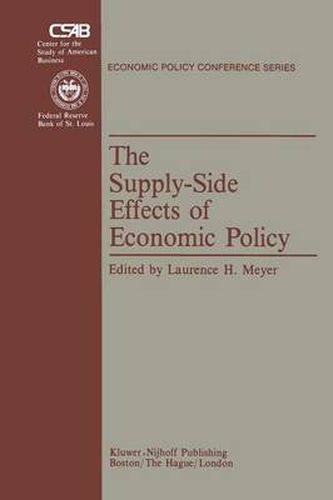Readings Newsletter
Become a Readings Member to make your shopping experience even easier.
Sign in or sign up for free!
You’re not far away from qualifying for FREE standard shipping within Australia
You’ve qualified for FREE standard shipping within Australia
The cart is loading…






This title is printed to order. This book may have been self-published. If so, we cannot guarantee the quality of the content. In the main most books will have gone through the editing process however some may not. We therefore suggest that you be aware of this before ordering this book. If in doubt check either the author or publisher’s details as we are unable to accept any returns unless they are faulty. Please contact us if you have any questions.
On October 24 and 25, 1980, the Center for the Study of American Business at Washington University and the Federal Reserve Bank of St. Louis cosponsored their fifth annual conference, The Supply-Side Effects of Economic Policy. This volume contains the papers and comments delivered at that conference. Proponents of supply-side economics have challenged the policy recommendations that emerge from Keynesian macroeconometric models. These models focus on the effects of economic policy on the demand for output. Supply-side economics, in contrast, emphasizes the response of output to changes in the supply of inputs. Decisions affecting the capital stock and employment-in particular, saving and investment decisions and labor force participation and hours decisions-are the focus of the supply-siders’ attention. The 1980 conference examined most of the major themes associated with supply-side economics. The papers in Part I of this volume develop the theory underlying various supply-side propositions and present empirical evidence in support of some of these propositions. In Part II, the effect of taxes on capital formation and the effect of increased capital formation on output growth and inflation are examined. The effect of tax and transfer programs on labor supply, employment and unemployment are examined in Part III. The final section contains the special luncheon and dinner presentations.
$9.00 standard shipping within Australia
FREE standard shipping within Australia for orders over $100.00
Express & International shipping calculated at checkout
This title is printed to order. This book may have been self-published. If so, we cannot guarantee the quality of the content. In the main most books will have gone through the editing process however some may not. We therefore suggest that you be aware of this before ordering this book. If in doubt check either the author or publisher’s details as we are unable to accept any returns unless they are faulty. Please contact us if you have any questions.
On October 24 and 25, 1980, the Center for the Study of American Business at Washington University and the Federal Reserve Bank of St. Louis cosponsored their fifth annual conference, The Supply-Side Effects of Economic Policy. This volume contains the papers and comments delivered at that conference. Proponents of supply-side economics have challenged the policy recommendations that emerge from Keynesian macroeconometric models. These models focus on the effects of economic policy on the demand for output. Supply-side economics, in contrast, emphasizes the response of output to changes in the supply of inputs. Decisions affecting the capital stock and employment-in particular, saving and investment decisions and labor force participation and hours decisions-are the focus of the supply-siders’ attention. The 1980 conference examined most of the major themes associated with supply-side economics. The papers in Part I of this volume develop the theory underlying various supply-side propositions and present empirical evidence in support of some of these propositions. In Part II, the effect of taxes on capital formation and the effect of increased capital formation on output growth and inflation are examined. The effect of tax and transfer programs on labor supply, employment and unemployment are examined in Part III. The final section contains the special luncheon and dinner presentations.